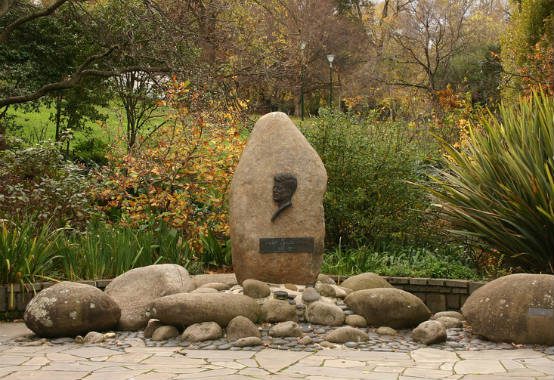Camelot in Australia

“If you go down to the woods today,” the children’s song warns us, “you’re in for a big surprise”; but if you go down today to Melbourne’s Treasury Gardens—greenest of local green lungs, a veritable Central Park for Australia’s second-largest city—you’re in for an even bigger surprise. To wit, the sole John Fitzgerald Kennedy memorial in the world which appears to have escaped the attention of Arthur Schlesinger.
The memorial is so beautifully designed, with fountains gushing forth every which way, that comparisons with the Villa d’Este outside Rome are not entirely stupid. But surprisingly few Melburnians know the thing exists. From the accompanying plaque, near the bas-relief of JFK at the memorial’s center, we learn that the memorial was formally declared open in 1965. We also learn something rather odd: the identity of the man who opened it.
You would think, wouldn’t you, that in 1965 such a memorial would have been opened either by the prime minister of Australia or by the premier of Victoria. The prime minister in 1965 was Sir Robert Menzies, approaching retirement. Meanwhile the premier of Victoria was Sir Henry Bolte, a Protestant counterpart to Québec’s Maurice Duplessis. Underneath his hayseed veneer Bolte had a mind like a Swiss army knife and the ability to win six consecutive elections.
(Even Bolte, though, found himself conceding temporary defeat against that extraordinary Catholic activist B.A. Santamaria, a one-man Deep State. Santamaria then had a preoccupation with trying to secure governmental subsidies for Catholic schools, a preoccupation which—as he afterwards admitted, though not in these exact words—showed little more strategic wisdom than securing governmental subsidies for Bill Clinton’s Viagra. Sir Henry depended on the Santamaria-controlled vote to retain Victoria’s premiership. The story goes that after one exasperating session with B.A.S., Bolte complained: “You’re blackmailing me, aren’t you?” “Yes,” came Santamaria’s imperturbable response.)
Actually neither Menzies nor Bolte had any discernible connection with the Kennedy monument. The job of 1965 ribbon-cutter was delegated to Melbourne’s mayor at the time, a certain Leo Curtis, otherwise unknown to history, without even the kudos of his own Wikipedia page. (The online encyclopedia’s list of Melbourne mayors calls him “Edward Leo Curtis” but the plaque doesn’t.)
Could there be a sociological lesson here? Whilst by 1965 the very worst of Australia’s Catholic-Protestant aversion had eased, it remained active, and nowhere in Australia did it remain more alive than in Melbourne itself. We are not, admittedly, talking about Belfast-style levels of mayhem, nor about Klansmen burning down convents. But much later than 1965, whole strata of Australian society considered mutual stone-throwing by Catholic and Protestant schoolchildren to be an entirely natural, indeed legitimate, mode of political discourse. Federal and state civil service departments continued to be organized strictly on Catholic-versus-Protestant (the latter often de facto Masonic) lines.
A recently published memoir by Greg Sheridan, for over two decades foreign editor at The Australian, contains in its opening chapters—which deal with Sheridan’s own Sydney schooling by the Christian Brothers, whose severest punishments included addressing Sheridan as “Gregory”—a memorable illustration of how deep the sectarian divide remained hereabouts when Lee Harvey Oswald struck. Once the news came through on Australian radio (surprisingly few Australian households then could boast television), Sheridan’s father supplied his own verdict. Asked why JFK had been killed, Sheridan Senior spat out the words: “He was a n*****-loving Catholic.”
Please bear in mind that Sheridan Senior constituted one tough blue-collar near-genius, as anyone who ever had a solitary meeting with him will know. His home, at least in 1987, displayed a large and impressive portrait of Pius XII. He was the last person to entertain conspiracy theories. That such a man in 1963 could nevertheless explain Dallas marksmanship solely in those terms (mere weeks, mind you, after Ngo Dinh Diem had paid with his life for trusting in the authenticity of JFK’s Catholicism) indicates the kind of cultural apartheid in which Australia’s Catholics and Australia’s Protestants then dwelt. Intermarriage remained surprisingly common, inter-friendship uncomfortably rare.
Sometime you might find yourself in Melbourne on a non-rainy day. If so, then do take the half-hour opportunity to visit the memorial. There you can have frazzled nerves soothed by the sound of rushing water and the occasional quacking of an apolitical duck. There, too, you may choose to meditate upon destiny; upon stone-throwing kids; upon real-life Australian Catholic sex-abuse scandals worse than the most satanically imaginative cartoons in the vilest KKK pamphlet; and upon the greatest U.S. president ever to have his daddy and a Chicago boss steal an election for him.
R.J. Stove is the author of César Franck: His Life and Times.
Comments